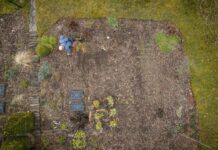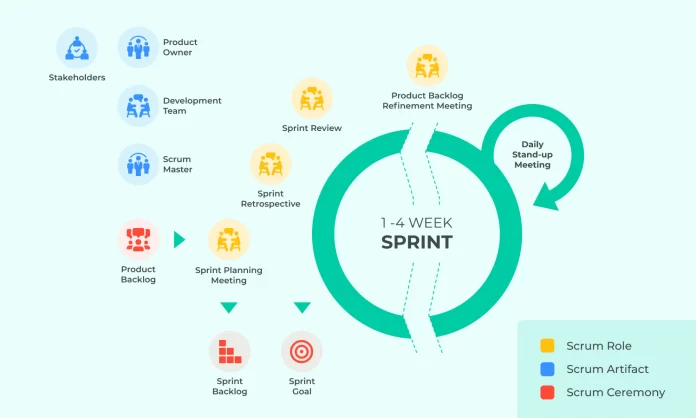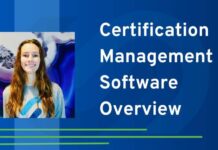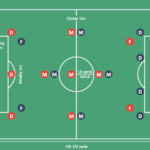Scrum is primarily one of the subsets of the agile methodology or framework. It is the most effective and widespread method these days. It has provided great results towards the growth of the companies. So, if you are keen on learning Scrum and its methodologies deeper, you are at the right place. This article will be digging a little deeper into the Scrum Lifecycle, the artifacts, and much more. Apart from that, if you’re willing to be a Scrum Master yourself, then do check out the CSM Certification program by Simplilearn. So, let’s go-
What is Scrum?
Scrum is basically a methodology that helps production systems to run smoothly. It is a popular framework that can be applied for product development. It helps teams involved in the product development to hypothesize the working patterns, test their innovations, formulate new ideas, process the product, improve the quality simultaneously and make changes accordingly. It provides flexibility to the traditional structured and end to end process. This is done by dividing the complete process of production into smaller and simpler steps called Sprints. This forms the basis of Scrum as a whole.
The roles of the Scrum and the Scrum team
There are a lot of Responsibilities that a typical Scrum team holds. Here are a few key functions that they play in the organization-
- Firstly, their job is to recognize the organization’s process to develop the product. And then divide it into tasks for separate departments and define their roles and responsibilities.
- Arranging Scrum meetings on a daily basis. This ensures that all the assigned tasks of the department are running smoothly.
- They supervise and make sure that the functioning of each task is being done correctly after every Sprint.
- Lastly, they update all the sprints and also formulate the Sprint burndown diagram.
And a typical Scrum team includes the following four members who have specified roles in product development-
The first one is the Product Owner:
This person is responsible for formulating the product from scratch; he is the one who decides all the features and approves the product. He is responsible for bringing out the return on investment for the product. He also prioritizes tasks that define the delivery of the product for the next Sprints. He has to ensure timely delivery of the product and also communicate with the clients. He has a very primary and fundamental role in the entire production process.
Next is the Scrum Master:
A Scrum Master is a person who is well versed with the methodologies and principles of Scrum and Agile. He basically helps the team to apply and learn the basic concepts of Scrum and help them make the most of the product through the business principles of Scrum. He is neither the project manager nor the team lead; he is more like a mentor to the entire team. They educate and Guide Product owners to churn out huge revenue from their products through Scrum and Agile practices.
If you are willing to be a Scrum master and mentor huge multinational companies, then do check out the CSM certification program by Simplilearn.
Further, an entire development team follows the product process laid out by the product owner and the Scrum Master. They are involved in the making of the product. And lastly there is a group of Stakeholders. These people are the most affected due to the outcome of the product.
So, here’s some of the basic terminology about Scrum, also do not forget to check the CSM Certification program by Simplilearn.
What is Scrum Life cycle and its artifacts?
The Scrum life cycle is the number of consecutive steps or iterative stages that should be followed to complete a Scrum project. The entire work of the Scrum project is divided into simpler and smaller steps called Sprints. The complete project develops when each and every Sprint gets completed one after the other. These Sprints are further divided into subgroups too. There are also specialized Lifecycles for specific tasks, for example testing Life cycle or defect life cycle. Now these Life cycles are defined by the various artifacts that are part of the process. Here are a few key ones-
- Project Backlog:
It is basically a list of tasks that are needed to be done for the project arranged in the order of priorities. It is the features, changes, improvements, and resolutions needed in the product.
- Sprint Backlog:
This is the list of things that are to be completed in one particular Sprint. It has a detailed plan for completing user stories and also activities that are typically needed to be addressed in the sprint.
- Product Increment:
This basically predicts or decides or more specifically assigns how the product should turn out after each and every sprint. It is a prototype of the draft version of the actual product. Every product increment should contain the features presented at each sprint.
This was all about the Scrum life cycle. So, what are you waiting for? This could be your chance to be a Scrum master and work with some of the biggest companies around the globe. All you need is a CSM Certification and voila! Your next level of the career is unlocked. In Simplilearn’s CSM Certification, you get to choose for the offline/ online classes. These are mostly for the weekend and you get to learn a ton of things about Agile and Scrum. Post the completion of the syllabus, you need to take the test of 50 questions and get nearly 37 or more correct to obtain the Scrum Master certificate. All you need to enroll for the CSM certification program is an interest in the subject, as there are no other prerequisites. Plus, you get endless benefits from this deal. Buy this program from the Simplilearn website today and become a Scrum Master.


































































